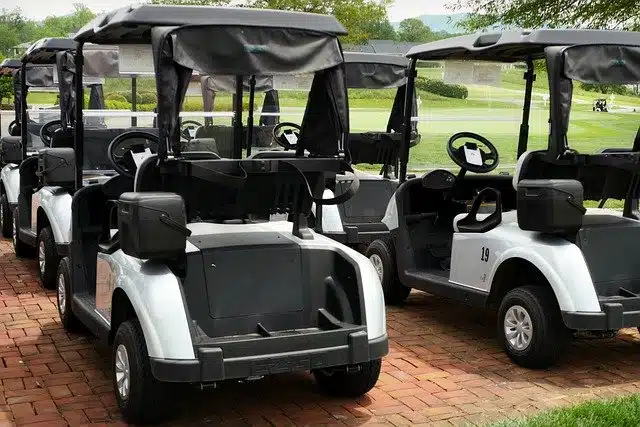Knowing how long it takes to charge a golf cart can help ensure you’re not stuck at home with a dead battery. As someone passionate about golf with my own cart, I researched the length of time it takes to charge a golf cart battery.
How long does it take to charge a golf cart? It takes about 3 to 8 hours to charge a golf cart fully, but it could take up to 14 hours. If your battery is new and not fully drained, it could take 3 hours. If your battery is fully drained, it could take 8 hours. If your battery is old, fully drained, and poorly maintained, it could take 14 hours to charge.
But the battery age, maintenance, and how much it’s drained are just a few factors to consider. Anyone considering golf cart charge times will want all the info so you don’t miss out on a day on the course with a dead cart.
Read on to learn more info about how long do you charge a golf cart:
- Tips to reduce golf cart charging times
- How to fix your golf cart charger
- The top 3 golf cart battery killers
- How to store your golf cart battery in winter
- FAQ about golf cart battery charge times
Let’s dive in!
How Long Does It Take To Charge A Golf Cart?
One of the frequent questions golf cart owners ask is, “How long does it take a golf cart to charge?” The answer isn’t always straightforward, as various factors come into play. On average, the charging time for a typical golf cart battery can range from 3 to 14 hours, depending on several conditions.
Average Charging Times for Golf Cart Batteries:
| Depth of Discharge | Average Charging Time |
| Minimal Discharge | 3 hours |
| Moderate Discharge | 6 hours |
| Heavy Discharge | 8 hours |
| Almost Dead | 12-14 hours |
Why It Might Take a Shorter Time For Your Golf Cart To Charge
- Minimal Use: If the golf cart was only used briefly and the battery hasn’t been heavily discharged, it would require less time to top up.
- High-Quality Chargers: Modern, efficient chargers can often recharge batteries faster than older or lower-quality models.
- Regular Maintenance: Batteries that are well-maintained (clean terminals, proper electrolyte levels) can charge more efficiently.
- Optimal Environmental Conditions: Batteries charge best at room temperature. The battery might charge slightly faster if it is in a warm (but not too hot) environment.
Why It Might Take a Longer Time For Your Golf Cart To Charge
- Deep Discharge: The more drained the battery, the longer it will take to recharge. If it’s completely dead, the charging time extends significantly.
- Battery Age: As batteries age, they can’t hold the same charge as they once did, leading to longer charging times.
- Charger Issues: A malfunctioning charger or one unsuitable for the battery type can result in extended charging periods.
- Cold Temperatures: Batteries tend to charge more slowly in cold conditions.
- Initial or Conditioning Charge: New batteries or those that have been reconditioned may take longer during their first few charges.
Factors Affecting Golf Cart Battery Charge Times
- Battery Capacity and Type: Different batteries have different capacities, and the type of battery (like lithium-ion vs. lead-acid) can influence charge times.
- State of Discharge: The more drained the battery is, the longer it will take to recharge.
- Charger Efficiency: Not all chargers are made equal. Some are more efficient and can charge batteries faster.
- Battery Age and Health: Older or poorly maintained batteries might take longer to charge.
- Environmental Conditions: Extreme hot and cold temperatures can impact how efficiently a battery charges.
- Maintenance Habits: Regular maintenance can keep batteries in optimal condition, ensuring faster and more efficient charging.
Understanding how long it takes a golf cart to charge is essential for every golf cart owner. Regularly monitoring and maintaining your golf cart battery will ensure efficient charging and prolong the battery’s lifespan.
Reduce Golf Cart Charging Time With These Tips
- Keep Batteries Clean—Dust, dirt, and grime can quickly accumulate; keeping them clean helps in detecting any signs of trouble and avoiding any associated problems. To preserve your batteries, make sure to keep the tops dry, clean, and firmly tightened. You can use a bristle brush and a solution of baking soda and water for a thorough cleaning, but wearing eye protection and rubber gloves is essential.
- Optimal Charger—Fast chargers are becoming increasingly common due to their efficiency in reducing golf cart charging time. Instead of waiting up to 14 hours, owners with lead-acid batteries can expect their carts to be back on the course within 4-6 hours if they use a compatible fast charger. To ensure that your charger is the right fit for your battery, it is crucial to check its compatibility.
- Only Charge Cool Batteries—We’re not referring to the social status of your batteries but rather their temperature. It may be surprising, but the temperature can influence how long your golf cart takes to charge. Recharging the battery in cooler temperatures is recommended because heat can interrupt the charging system, causing it to be less productive. If the charger gets too hot, it will not be able to work optimally in comparison to one that is kept in cooler conditions.
How To Fix Golf Cart Charger Problems
Troubleshooting your golf cart battery should be a relatively simple process. There is only so much that can go wrong as opposed to gas-powered golf carts.
The cable connections are the first aspect to inspect on your golf cart. There can be some unexpected and rough terrain when you’re out on the course, so it’s common for these to become ajar.
Ensure you’re checking one at a time and not allowing your wrench to connect two contact points; it will hurt.
Before you tighten everything down, clean out any dust or corrosion from on top of the battery as well. This draws energy and could cause your charger not working correctly.
Don’t Forget About Adding Water To Your Golf Cart Battery
Often overlooked by new cart owners is the water. Inspect the batteries monthly after installing them to determine the watering schedule. It’s essential to be aware of when and how much to add water, or else the battery’s performance and durability may be affected.
Always water the cells after charging is complete, and ensure there is enough water to cover the plates before charging. Water should be above the plates if the battery has been partially or fully discharged.
Water should be added accordingly to ensure that the correct water level is maintained after a complete charge. After a few months, you’ll know what works best for how often the battery will need watering for your climate, charging method, and application.
As batteries age, they tend to require more maintenance. This usually involves topping off the battery water levels more often and requiring a longer charging time. Additionally, the battery capacity tends to decrease with age.
Top 3 Golf Cart Battery Killers
Whatever you do, avoid these like the plague to ensure your healthily charging a golf cart battery.
1. Heat
When storing your golf cart, it’s advised to stay away from strong heat sources, like radiators or space heaters, as temperatures above 80° F (26.6º C) can result in an increased rate of battery draining.
2. Freezing Temps
Staying clear of areas with frigid temperatures is essential, as a battery’s plates and container can be damaged beyond repair if it gets too cold. Keeping the battery at a fully charged level is recommended to ensure this does not happen.
3. Over-Charging
For optimal performance, it’s best to use an automatic golf cart charger to keep your batteries fully charged without over-charging. This will extend the life span of your batteries and ensure they are always ready to use and safe. Operating the batteries in a partially charged condition should be avoided, as this can reduce their overall capacity.
Best Golf Cart Battery Chargers To Reduce Charging Time
1. YILEIDE E800W Series 48V15A Golf Cart Battery Charger
Pros
- Compact design
- Multiple safety features
- Intuitive charging indicator
- Cost-effective
- Fast charging
Cons
- Cooling fan noise
I’ve had the chance to use the YILEIDE E800W Series 48V15A Golf Cart Battery Charger. The compact size is a boon, easily fitting into the storage compartments of my golf cart. It’s been a significant upgrade in terms of charging time, especially when compared to my older chargers. The intelligent auto shut-off feature has been a lifesaver when I’ve been a tad forgetful, preventing battery drain.
However, one minor hiccup I’ve noticed is that the cooling fan can get a bit noisy sometimes.
Comparing the YILEIDE with the YHCHKJ Golf Cart Battery Charger, while the latter offers versatility with its 48V 13A and 36V 18A trickle charging, the YILEIDE stands out with its faster charging capabilities and compact design. Both are excellent, but the YILEIDE has been the optimal choice for my EZ-GO golf cart.
2. YHCHKJ Golf cart Battery Charger
Pros
- Versatile charging (36V/48V)
- Comprehensive battery support
- Intelligent charging system
- Built-in safety features
- Informative LCD display
- Lightweight
Cons
- Vulnerable to water
I tried the YHCHKJ Golf Cart Battery Charger on my 48v Club Car, and it’s mainly been a positive experience. This charger intelligently adjusts to the battery type and even includes features like trickle charging and sulfate layer detection.
The LCD display is a great touch, showing useful data like voltage and charging percentage. While I did have to make minor modifications to fit my specific cart’s setup, the convenience post-modification has been noteworthy.
However, a significant downside I’ve noticed is its susceptibility to water. Even a light rain shower can damage it if left outside. I’d recommend being cautious about where you place this charger during use.
While YILEIDE E800W and YHCHKJ offer advanced charging features, YHCHKJ stands out with its versatility for multiple vehicles and battery types.
3. Flngr 48 Volt Golf Cart Battery Charger
Pros
- 10Amp trickle charge
- 6-10 hour full charge
- Smart charging
- Compatible with EZGO
Cons
- Not specified (will base on experience)
The Flngr 48 Volt Golf Cart Battery Charger has been my go-to for my EZGO RXV. With its 10Amp trickle charge capability, I’ve always been assured of a consistent charge without risking battery damage.
Typically, a full charge takes about 6 to 10 hours, which suits my schedule perfectly. One of the aspects I value most is its smart charging feature; it seems to adapt and deliver the right charge without me having to constantly monitor it. The compatibility with the EZGO line makes it even more convenient. One minor issue I’ve had, though not deal-breaking, is the charger sometimes gets a bit warmer than I’d like.
The Flngr 48 Volt Golf Cart Battery Charger offers consistent and smart charging tailored for the EZGO RXV&TXT. Its 6-10 hour full charge timeframe and 10Amp trickle charge ensure your batteries get the right amount of power without overcharging.
Best Golf Cart Batteries To Reduce Charging Time
1. Lifeline Marine AGM Battery GPL-31T
Pros
- User-friendly, you’ll get the hang of it quickly
- Good with most chargers out there
- Vibration-resistant
- 750 life cycles
Cons
- Kinda on the heavy side.
Lifeline designed this battery with sailors in mind, which means it’s ready for some serious action and reliability. The fact that the US Coast Guard approves it? Just means it’s got that extra layer of robustness.
But here’s the kicker – if it’s tough enough for the high seas, imagine how great it’ll be on the green! Golf carts can totally ride the wave with this one. It’s got a deep-cycle vibe, top-notch leak protection, and a sweet 220Ah capacity for those long golf adventures.
Plus, Lifeline’s so confident in its performance that they slapped on a 5-year warranty. All in all, it’s marine-grade for your cart – talk about an upgrade!
No one uses this because they don’t know it works great for golf carts. But if you pick it up, you’ll be happy you did.
2. Trojan T-105 Batteries
Pros:
- Up to 750 charges and 200 rounds of golf
- Top-quality brand
- 2-year full replacement warranty
- Lowest cost amp-per-hour battery on the market
Cons:
- Requires relatively high maintenance e.g. watering and maintaining clean terminals for best results
Pros
- 750 charges, which is around 200 golf rounds
- Top brand
- 2-year full replacement warranty
- Best cost per amp-hour
Cons
- Needs some love and care. Think watering, cleaning terminals, etc.
Trojan’s been around since the ’20s, and they’re like the Tiger Woods of golf cart batteries. Super reliable with a stellar life cycle. It’s the kind of battery that won’t give up on you soon. The T-105’s deep cells keep it from degrading fast, so it’s a gem for frequent, high-power users. It’s kinda old-school, but man, the quality’s still top-notch. A no-brainer to at least give this one a thought!
3. UPG UB12350 Battery
Pros
- Great value
- Maintenance free
- Spill and vibration proof
- Year warranty
Cons
- Don’t go below 50% charge
- Might start showing its age over time
UPG’s been powering stuff since ’68, and their UB12350 battery? A solid choice for golf carts. No need to babysit this one – it’s sealed and nearly maintenance-free. Plus, it’s ready for some rough rides with its spill-proof design. It’s packed in a tough shell that won’t shatter easily. If you’re looking for a strong, reliable battery that won’t break the bank, this could be your guy!
Do’s and Don’ts for Storing Your Golf Cart in the Winter
For those unlucky enough to live in the frigid north, you must go through a few extra steps before putting your cart away for the winter. Knowing how to store your batteries is just as important as knowing how often to charge golf cart batteries.
Be sure to switch your cart to “Winter Charging Mode” to prevent battery damage.
Do’s
- Store in a dry place like a garage or shed. The location does not have to be heated.
- To prevent electrical arcing, confirm that the charger isn’t loose in the wall outlet.
- Invest in a high-quality charger that knows to turn off once a full charge is achieved.
- Always leave your cart plugged in to prevent any type of freezing.
Don’ts
- Do not leave you’re cart outside. It should be kept dry and away from rain or snow build-up.
- Do not pile anything on top of the batteries.
- Do not drain water; this will stay unfrozen by the charger and is needed to not ruin the batteries.
FAQ
How Long Does It Take To Fully Charge 36 Volt Golf Cart?
It typically takes around 4-6 hours to fully charge a 36 Volt golf car using an onboard charger. Most 36 Volt golf cars feature 36 6-Volt batteries that are connected in series to create the 36 Volt system. Most onboard chargers are capable of charging at a rate of around 6 amps per hour, so it will take between 4-6 hours to reach a full charge but could take as long as 12 hours, depending on various other factors.
How Long Does A 48 Volt Golf Cart Take To Charge?
Generally, it takes around 8-9 hours to fully charge a 48 Volt golf car but could take up to 14 hours. The time it takes to fully charge a 48 Volt golf car depends on a few factors, including the charge and discharge rate of the battery, the voltage of the charger, and the condition of the battery itself.
Should I Keep My Golf Cart Plugged In All The Time?
No, it is not recommended to keep your golf cart plugged in at all times. Overcharging the battery can lead to a variety of problems, such as reduced battery life, corrosion, and even fire. It is best only to plug in your golf cart when necessary and make sure that it is unplugged after charging is complete.
Is It Safe To Leave A Golf Cart Charging Overnight?
Yes, leaving a golf cart charging overnight is safe as long as you follow the appropriate safety precautions. Ensure you follow the manufacturer’s instructions for charging the battery and ensure the plug or charger functions correctly.
Can You Use A Golf Cart Without Fully Charging It First?
Yes, you can use a golf cart without fully charging it first. However, it’s recommended that you fully charge the golf cart before you start using it to ensure optimal performance and avoid any potential issues with battery life. If you do decide to use the golf cart without fully charging it first, you should pay close attention to the battery level while you’re out on the course so you don’t get stranded.
Read more: Should I Leave My Golf Cart Plugged In All The Time?
Summary—How Long To Charge Golf Cart
Understanding the intricacies of golf cart battery charging is paramount for any passionate golfer. One might wonder, “How long does it take to charge a golf cart?” and the answer varies. It typically takes 3 to 8 hours to charge a golf cart battery fully. However, depending on the battery’s condition and age, this could stretch to 14 hours.
Factors influencing this timeframe range from the battery’s discharge state, overall health, and the charger’s efficiency. Environmental conditions, such as extreme temperatures, can also play a role. Regular maintenance of the battery, ensuring it is kept clean, and using optimal chargers can drastically reduce charging time.
Nevertheless, it’s crucial to remember that as batteries age, they may demand increased care, including regular watering and longer charging durations. Stay vigilant to potential battery killers like extreme temperatures and over-charging. Utilizing an automatic charger can be a game-changer, maintaining the battery’s health without the risk of overcharging.
To sum it up, gauging how long it takes to charge a golf cart depends on many factors. Staying informed and attentive to your golf cart’s battery needs will ensure it charges efficiently and extend its lifespan, making your golfing experiences uninterrupted and enjoyable.
Jack was inspired by his Grandad Ron’s golfing and grew up playing this great game. Jack has a handicap index in the 30s and plays with the PING K15 driver and irons. Jack has written more than 40 articles on GolfSpan since 2022. Jack is always looking for ways to find the edge on the course to share with readers and played monthly at High Legh Golf Club near his home in Warrington, Cheshire. You can connect with Jack on X and LinkedIn.
- Best score: 94
- Favorite club: PING K15 driver
- Favorite putter: Wilson ProStaff OD+ putter
- Favorite food at the turn: Always a banana











